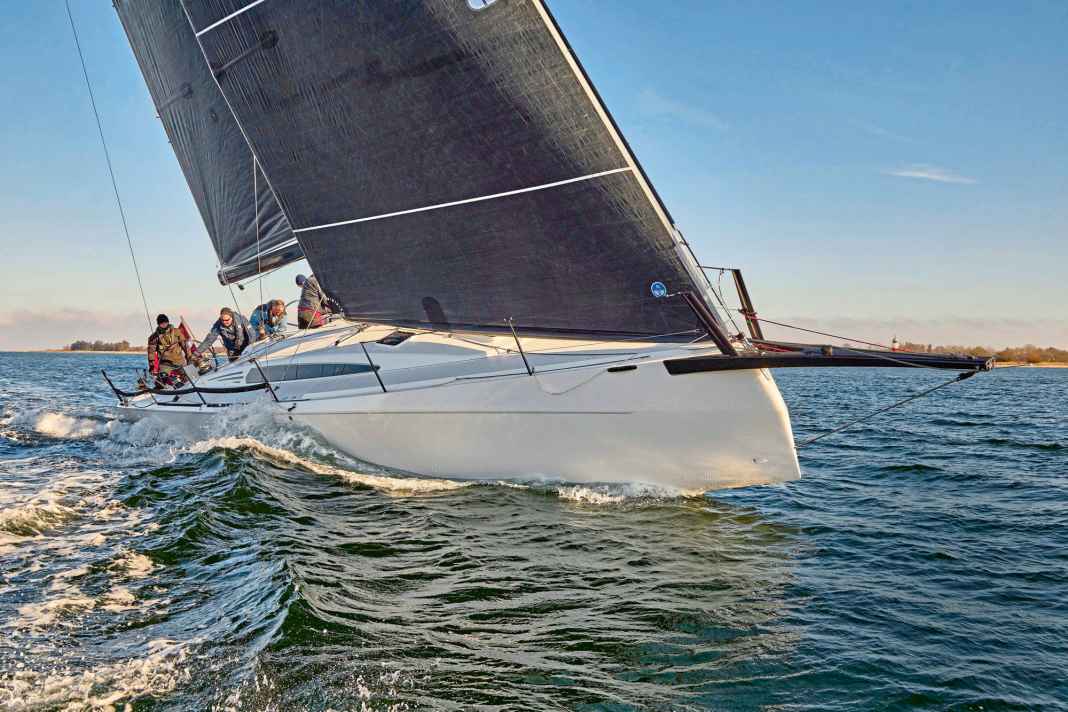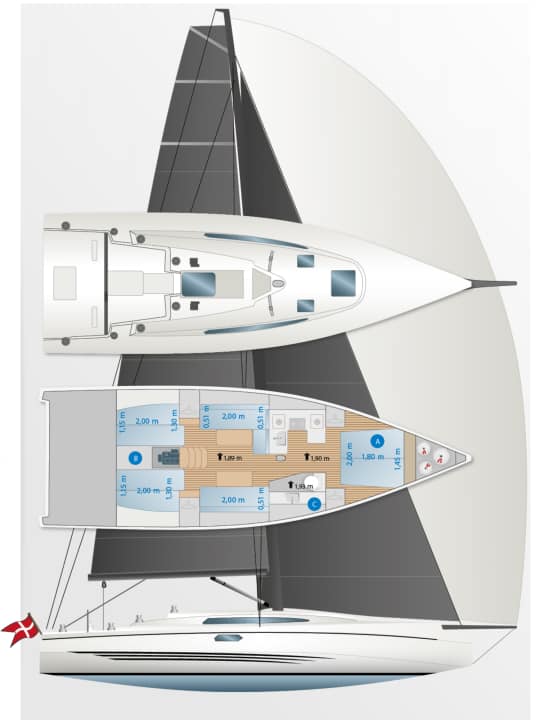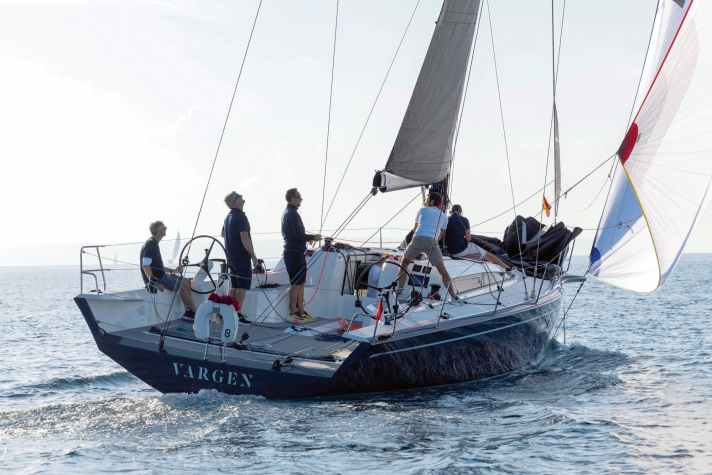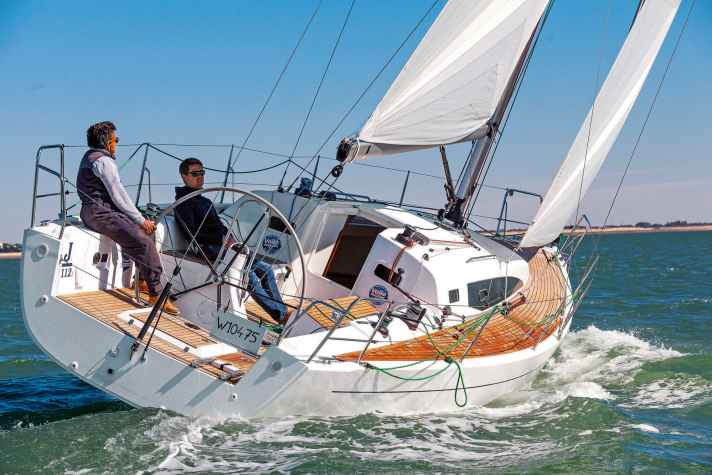





The man seems to be happy. Kraen Nielsen, CEO of X-Yachts, radiates even more dynamism and confidence than you would normally expect from the Dane; success makes you happy. Because his new XR 41 has been very well received. The star of boot Düsseldorf was sold 15 times before the leading trade fair on the Rhine. Today on the test day, a few weeks later, construction number 20 is being signed.
The boss comments: "In the past, we were quite closely positioned with our boats: The performance models in the Xp range, our all-rounder X Pure and the cruising yachts Xc were all quite close together. Now we are positioning ourselves more broadly: The new Xc 47 is even more of a cruising boat and our latest baby, the XR 41, is even more powerful and hotter than an Xp used to be. And in the large middle range, we are sticking with our successful X-Pure programme."
"The XR is hotter than an Xp was. And our cruisers are even more comfortable."
With the new project, X-Yachts wants to return to its roots in the still young era following the work of its founder and in-house designer Niels Jeppesen. These lie in regatta sailing at the highest level and at various levels. Yachts from Haderslev have won single-tonne world championships and were successful in the Admiral's Cup, international standardised classes such as the X-79 and the X-99 have been able to assert themselves on the scene, and more recently, boats of the X 41 type have repeatedly won silver medals at European and world championships according to the leading ORC (Offshore Racing Congress) measurement formula.
Read more about the shipyard:
And this story is set to continue. With the XR 41, the X-41 built from 2007 will have a successor with the potential to win the ORC World Championship in Estonia. X-Yachts is sending a factory crew into the race with Danish sailing professional Jesper Radich as skipper and can also hope for the services of experienced customers. Jens Kuphal's team ("Intermezzo"), which has been successful in the past with a Landmark 43, has acquired build number two.
Best of the best work together on XR 41
For the ORC World Championship victory, the shipyard indulged in a rarely great effort. Kraen Nielsen: "We thought up everything in-house for 45 years. Now we're doing it differently and bringing together the best of the best in this business."
The team of experts consisted of employees from North Sails, sailing professionals such as Bouwe Bekking and Jesper Radich, ORC optimiser Max Gurgel from Kiel, Danish designer and CFD expert Casper Nielsen and Thomas Mielec, Head of Design and Engineering at X-Yachts. The group devised and developed the concept, analysed the competition and worked through various optimisations for a favourable ORC rating. The goal: to be the fastest boat in ORC class B in order to be able to sail ahead of the field after the start with free wind and be capable of winning with a favourable race rating. Or as yacht optimiser Max Gurgel sums it up succinctly: "Fast on water, slow on paper."
The Number Cruncher has worked through various designs for the hull, the keel bulb, the keel fin and the rudder. The result of the intensive dialogue with his colleagues and X-Yachts man Mielec is a hull with an even volume distribution under water and little keel jump, a relatively long overhang of the full bow bent aft, reverse freeboard and an almost triangular transom. This is optimised for a good planing angle of around 20 degrees and barely touches the water without a planing angle, and the wetted water surface is also kept very small. The stern area also has gently hollow lines. "This," says designer Mielec, "is a result of the computer simulations. It reduces the stern wave and ensures better water drainage and less resistance."
Simply glide and not just surf
The bare figures also speak for good performance: the boat weighs just 7.14 tonnes, more than a third of which is in the keel. This means a high sail carrying capacity of 5.4 and, with a ballast weight of 2.65 tonnes, a proportion of 37 percent, with a draught of 2.4 metres.
One of the shipyard's requirements was that the boat should be a pleasure to sail under gennaker, even if this meant a poorer racing performance. Once again, one figure speaks in favour of the boat: in addition to the sail carrying capacity of more than five, the boat has a weight to waterline length ratio of around 124, which means that the XR 41 should be able to simply planing and not just surfing; for this it needs a DSPL/LWL ratio of no more than 180.
The design ensures the desired low weight. The XR is manufactured using the vacuum infusion process; the process stands for a healthy low and, above all, defined resin content. The sandwich consists of high-density foam, biaxial E-glass and partially inserted unidirectional carbon fibre, all bonded with epoxy resin. The X-typical steel frame carries the keel and the rigging forces; the hull, to put it bluntly, only serves to keep the water out.
350 kilograms of material can be temporarily removed using modules
In addition to the high-quality construction, the deep T-keel with bomb and the standard carbon rig, the X-Team uses a further measure to keep the weight low. With furniture modules in the cockpit and especially below deck, the boat can be converted from normal operation to race mode.
The crew then remove the aft segments of the cockpit dykes, making the genoa winches more ergonomic to operate, and remove parts of the interior. These are the forward berth, all the lockers, the saloon tables and the complete sink block in the galley. The parts are fastened with toggle bolts that can be operated without tools. Once everything has been removed, the boat has to move 350 kilograms less material and there is more space below deck for stowing sails and recovering and packing the gennaker.
The Danes are also breaking new ground below deck and putting performance in first place
What's more, the interior is beautifully light. Some of the bulkheads are made of composite, as is the furniture finished in imitation walnut. Another special feature is the layout: the galley and bathroom are at the front of the main bulkhead, while the saloon starts right at the companionway. Heavy parts are therefore positioned in the centre of the boat. There are also no tanks in the foredeck.
Below deck and under sail
Despite the hunt for less weight, the XR 41 is a fully-fledged cruising boat below deck, even if the storage space is a little tight and the aft berths could be wider. At least it offers amenities such as a large bathroom and a seaworthy galley. It is equipped with a semi-cardanic induction hob. An Airfryer is available as an option instead of an oven. Both are supplied via the powerful 24-volt on-board power supply with 160 ampere hours as standard and an optional 320 more.
And under sail? A dream! We set off from Aarö in the freezing cold and blue skies, the season is open, great. Around 12 to 14 knots and a tame, albeit quite short, wave pushes the boat light-footedly with just the right rudder pressure. With a true wind of around 40 degrees, speeds of between 6.8 and 7.2 knots can be achieved with a reduced crew on the edge. As soon as the wave flows more harmoniously, the speed immediately increases by two or three tenths. The acceleration after the tack is also worth seeing, as is the turning behaviour. The boat proves to be stiff. And the water drainage at the stern is a delight. The speeds are easy to call up, steering is a great pleasure, as are the carbon sails from North, which stand up like metal sheets.
The measured values of the XR 41





The deck layout does the rest. Eight powerful winches are available on request. All are easy to operate and easy to reach. The standard carbon mast from Axxon is positioned relatively far back, allowing a longer J and therefore larger headsails. In combination with the 1.80 metre race bowsprit, the result is a 190 square metre gennaker.
And now we want it to go up. A jolt almost goes through the ship, the XR 41 accelerates to nine knots, ten, eleven, let's see twelve today. The XR quickly leaves its own wave system and begins to glide without any wave support. The bow does not dig into the water, it lifts up onto its own wave. The long bowsprit makes jibing easier. The double backstay also poses no problems, no comparison with the lower-set backstays used in the past, which tended to get caught on the boom when jibing and provoked mast breaks.
The sternposts are fourfold reduced. The supposedly fixed ends extend below deck and are fine-tuned there with small hydraulic cylinders. The tension arriving at the forestay can be measured via a pressure box and the value read off one of the many MFDs. The cylinder is moved by an electric hydraulic pump, which is operated by a crew member in the cockpit at the push of a button.
If desired, the crew can also use this system to trim the mainsail foot, the tube kicker, the foresail haul points and the luff adjusters for the main and jib. The latter devices are necessary because the halyards of both sails are locked with halyard locks after setting, which saves weight in the rig and takes compression pressure off the mast. This means that no halyard is available for trimming. Buoys can be ordered as an alternative to the hydraulic system. The genoa lifting points can be moved in and out and up and down hydraulically on cross rails. The optional hydraulic system works; whether it is also reliable or has the potential to ruin the crew's day remains to be seen.
It also shows what the new XR 41 is capable of achieving against the competition, in particular the J/112E, the Italia Yachts 11.98 and the tried and tested X-41. A comparison with the latter is obvious: The XR is one foot longer for the same weight, carries twelve square metres more sail area and has between 20 and 25 percent greater righting moment at 20 degrees heel, with a "comparable rated upwind speed according to ORC", says Thomas Mielec.
The project sounds promising. Kraen Nielsen: "We have not yet decided whether we will bring out an XR in a different size later on. Next, we'll be focusing on a new Xcruising. The Xc 47 has been very well received and the market is demanding a larger model."
Prices of the XR 41
X-Yachts is having a good run, despite the high prices. The fully equipped XR 41 costs around 650,000 euros.
- Base price ex shipyard: 570.725 €
- Standard equipment included: Engine, sheets, railing, navigation lights, anchor/chain, fenders, mooring lines, battery, compass, cushions, galley/cooker, bilge pump, toilet, fire extinguisher, electric cooler, holding tank with suction, dumping/sail-clear delivery
- For an extra charge: Sail (main and genoa, North Sails NPL) € 34,070, sailcloth € 1,400, antifouling € 5,680, price ready to sail € 2611,875
- Guarantee/against osmosis: 2/5 years
Surcharge for comfort equipment
- Hole points: incl.
- Traveller with line guide: incl.
- Electric windlass: 6.620 €
- Tube kicker: incl.
- Backstay tensioner: incl.
- Jumping cleats: n.a.
- Sprayhood: incl.
- Teak in the cockpit: n.a.
- VHF radio: Electronics package
- Log and echo sounder: Electronics package
- Wind measuring system: Electronics package
- Autopilot: Electronics package
- Electronics package: 22.890 €
- Charger w. inverter: incl.
- Shore connection with RCD: incl.
- 230 volt socket (one): incl.
- 12-volt socket in the sat nav: incl.
- Heating: 6.520 €
- Pressurised water system: incl.
- Hot water boiler: incl.
- Shower/cockpit shower: incl.
- Comfort price: 647.905 €
- Included in the price: Carbon mast, boom and bowsprit, rod rig, lead keel in GRP hull, hot eye, induction cooker, lithium batteries, flush seacocks
As of 03/2025, how the prices shown are defined, read here!
This puts it well ahead of the previously proven yachts in the class and, above all, well ahead of a used X-41, which still has a chance of winning. And this is a dilemma of the shipyard's own making, as the longevity and high resale value would make its own older boats competitors in the boat market. A luxury problem.
YACHT rating of the XR 41
Planing, fast, strong even at the cross. In terms of potential, rig and deck layout, the XR 41 is more of a racer than a cruiser, but can be made more suitable for cruising by adding modules, a pinhead mainsail and a shorter bowsprit.
Design and concept
Clear alignment
Elaborate design
ORC-optimised on the shipyard side
Sailing performance and trim
Outstanding potential
Good sliding properties
Easily retrievable speed
Very high stability
Living and finishing quality
Removable extension modules
Very clean finish
/(-) Reduced interior space
Handrail on the ceiling missing
Equipment and technology
Carbon rig standard
Variants for the mainsail
Highly functional deck layout
The XR 41 in detail

Technical data of the XR 41
- Designer: Thomas MIelec/X-Yachts
- CE design category: A
- Torso length: 12,75 m
- Total length: 14,58/13,75 m
- Waterline length: 11,71 m
- Width: 4,18 m
- Draught/alternative: 2.40/tbc m
- Mast height above WL: 19,75 m
- Theor. torso speed: 8.0 kn
- Weight: 7,15 t
- Ballast/proportion: 2,65 t/37 %
- Mainsail: 59,1 m²
- Genoa (106 %): 49,3 m²
- machine (Yanmar): 21 kW/30 hp
- Fuel tank: 110 l
- Fresh water tanks: 250 l
- Holding tank: 35 l
- Batteries: 160 AH/24 V
Hull and deck construction
Sandwich with foam core and E-glass/epoxy resin laminate, manufactured using the vacuum infusion process. Tempered and partly reinforced with carbon. A steel frame absorbs the forces of the keel and rig.
Modules
Can be removed for less weight and more space: Cupboards, forward berth, galley sink module, tables, lockers.
Electrics
The service network works with 24 volts, 200 Ah are on board as standard, with a further 400 available to order. The induction hob and an optional airfryer, which replaces an oven, are powered by electricity.
Hydraulics
An electrically operated hydraulic unit with cylinders for the backstays, luff stretchers, mainsail and genoa, genoa lifting points and more is available as an option.
ORC measurement
According to initial calculations, the XR 41 has an ORC handicap (APH, All Purpose Handicap) of 493.4.
Shipyard
X-Yachts, Haderslev/Denmark, www.x-yachts.com
Distribution
X-Yachts Germany, cbarth@x-yachts.de
Competition from the XR 41
The competition on the railway is quite heterogeneous, also in terms of price and equipment.
All Purpose Handicap (APH): Example race value for the respective boat. The lower the value, the faster the boat is theoretically, the more time it has to pay for yachts with a higher value.
Italia 11.98

The alternative. Strong performer from the computer of ORC guru Matteo Polli. Vice world champion 2024, behind a Grand Soleil 44, also from Polli. Available in two versions. APH: 525.9. Read the YACHT test here.
ClubSwan 43

The noble one. Just as modern and large as the XR and just as smooth, but in class A. Exclusive. Open interior. Extreme profile. More racer than cruiser. Access to Nautor's regatta world. APH: 470. hull length 13.19 m; width 4.25 m; weight 7.5 tonnes; from 1,011,500 euros. Read the YACHT test here.
J/112E; J/36

The conservative one. Narrow stern and familiar hull lines. Fourth in the EM 2024. Successor to the J/36. Significantly smaller than the XR 41, but in the same group (B). APH: 526.6. YACHT test: Issue 20/2016.
X-41

The benchmark boat. Launched in 2007, the One Design became ORC European Champion 2024 after many successes. Classic performance cruiser. Wanted used boat. APH: 502.8. YACHT test: Issue 11/2007.

